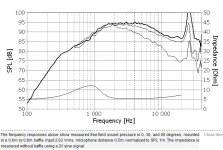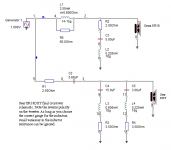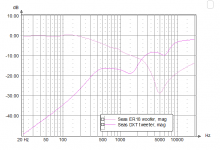John K,
Best written response I have seen to the conjugate network function and its effect on the loudspeaker. Just had this same conversation with a friend on the phone the other day and how to balance the three components to match the driver itself. There are more than one set of values that will match the basic impedance rise, but only one that is the exact set of values. I will copy this one section just to keep it in my face, Excellent work.
Steven
Best written response I have seen to the conjugate network function and its effect on the loudspeaker. Just had this same conversation with a friend on the phone the other day and how to balance the three components to match the driver itself. There are more than one set of values that will match the basic impedance rise, but only one that is the exact set of values. I will copy this one section just to keep it in my face, Excellent work.
Steven
Well, fantastic to have John K, Wolf and AllenB online and interested. 
Can I ask you flippin' crossover geniuses a question?
How would you calculate the RLC compensation circuit for SEAS' current proud DXT tweeter offering?
H1499-06 27TBCD/GB-DXT
I'm guessing something like 1.3mH, 25uF and 7 0hms with my limited tools:
Alan Yates' Laboratory - VK2ZAY's Engineering Calculators - LCR Resonance
Strassacker: Speaker Building, Components
I'm interested, because MarkK's interesting ER18DXT speaker just seems to notch around 1.6kHz and 6kHz, which is nowhere near the 900Hz resonance of the DXT tweeter and seems a bit strange.
Can I ask you flippin' crossover geniuses a question?
How would you calculate the RLC compensation circuit for SEAS' current proud DXT tweeter offering?
An externally hosted image should be here but it was not working when we last tested it.
H1499-06 27TBCD/GB-DXT
I'm guessing something like 1.3mH, 25uF and 7 0hms with my limited tools:
Alan Yates' Laboratory - VK2ZAY's Engineering Calculators - LCR Resonance
Strassacker: Speaker Building, Components
I'm interested, because MarkK's interesting ER18DXT speaker just seems to notch around 1.6kHz and 6kHz, which is nowhere near the 900Hz resonance of the DXT tweeter and seems a bit strange.
Attachments
What changes is the impedance the upstream elements in the crossover network see, and how they interact with that impedance.
I never said the drivers' characteristics change. I said the LCR damps the Fs in terms of system (your word and better description) results.
We are in agreement, John. That's why I said chicken or egg...
Later,
Wolf
We may be down to splitting hairs here Wolf but I'd have to disagree still.
If you look at the response of a typical dome tweeter at its Fs, it's often down in relation to the passband as a result of mechanical damping of the resonance. This type of plot is done at a constant voltage at the terminals. Peaking that may be produced as a result of electrical network source impedance is an extraneous factor and it is therefore wrong to see it as the benchmark. Conjugating the impedance peak only restores the potentially constant voltage input notwithstanding the desired shaping.
If you look at the response of a typical dome tweeter at its Fs, it's often down in relation to the passband as a result of mechanical damping of the resonance. This type of plot is done at a constant voltage at the terminals. Peaking that may be produced as a result of electrical network source impedance is an extraneous factor and it is therefore wrong to see it as the benchmark. Conjugating the impedance peak only restores the potentially constant voltage input notwithstanding the desired shaping.
I know it's been a decade but I never used my Neo tweeters in my proposed built, I went with the D27-45 instead. So I have to ask if the conjugate network was used ?
I want to use the Neo tweeter soon and if I need to use a conjugate I'll start saving for the extra components now. While the big tweeters paperwork suggested the need for the resonance trap I never bothered but if I need it with the tweeter with the much higher Fs I'll add it.
I want to use the Neo tweeter soon and if I need to use a conjugate I'll start saving for the extra components now. While the big tweeters paperwork suggested the need for the resonance trap I never bothered but if I need it with the tweeter with the much higher Fs I'll add it.
- Status
- This old topic is closed. If you want to reopen this topic, contact a moderator using the "Report Post" button.


